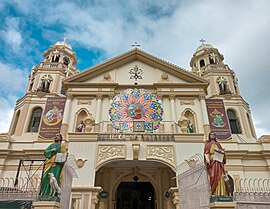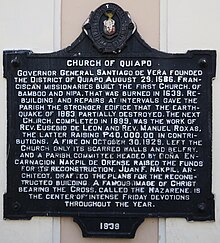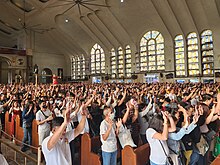Quiapo Church
| Quiapo Church | |
|---|---|
| Minor Basilica and National Shrine of Jesus Nazareno (Black Nazarene) | |
| Saint John the Baptist Parish | |
 Main façade in December 2023 | |
 | |
| 14°35′56″N 120°59′02″E / 14.598782°N 120.983783°E | |
| Location | Quiapo, Manila |
| Country | Philippines |
| Language(s) | Filipino |
| Denomination | Catholic Church |
| Tradition | Roman Rite |
| Website | Quiapo Church |
| History | |
| Former name(s) | Church of the Camisa[1] |
| Status |
|
| Founded | 1588 |
| Founder(s) | Antonio de Nombela |
Style | Mexican Baroque |
| Years built |
|
| Groundbreaking | 1933 (main façade) 1984 (expansion) |
| Completed | 1935 (main façade) 1986 (expansion) |
| Construction cost | ₱8 million (expansion)[2] |
| Specifications | |
| Capacity | 1,000 (seating)[3] |
| Length | 78.8 m (259 ft)[4] |
| Width | 33.0 m (108.3 ft)[4] |
| Nave width | 11.5 m (38 ft)[4] |
| Width across transepts | 33.0 m (108.3 ft)[4] |
| Other dimensions | Façade facing southwest |
| Floor area | 2,410.5 m2 (25,946 sq ft)[2] |
| Number of domes | 1 |
| Number of towers | 2 |
| Materials | Reinforced concrete |
| Administration | |
| Province | Manila |
| Metropolis | Manila |
| Archdiocese | Manila |
| Deanery | Jose de Trozo[5] |
| Parish | St. John the Baptist |
| Clergy | |
| Rector | Rev. Fr. Rufino C. Sescon, Jr. |
| Vicar(s) |
|
| Assistant priest(s) |
|
 | |
The Minor Basilica and National Shrine of Jesus Nazareno (Black Nazarene),
History
Early churches
The earliest church, built by missionaries of the
During the
Present church

In 1933, Magdaleno Castillo began the reconstruction of the church from the plan prepared by National Artist of the Philippines architect Juan Nakpil – son of composer Julio Nakpil.[8] He added the church's dome and a second belfry to balance out the façade. The reconstructed church, made of reinforced concrete, was completed in 1935. During World War II, parts of Quiapo were destroyed except for the church.[9]
In 2006, the church celebrated 400 years since the Black Nazarene’s arrival. As part of the celebrations, a jubilee wall was placed at the entrance gate so devotees can post their own testimonials of faith and devotion to the Black Nazarene. The Traslación from Quirino Grandstand back to the basilica was also introduced, re-enacting the image's initial transfer from its destroyed shrine in Intramuros.[11]
On May 10, 2023, Cardinal
On January 29, 2024, at the end of the CBCP's 127th Plenary Assembly in Manila, a
Architecture
Built in the
During its expansion, changes to the building were made, such as the removal of the ornate exposed trusses, the removal of the interior columns to create an expansive columnless structure, and the realignment of the perimeter walls. Even though Zaragoza did not tamper the facade and altar area, this received criticisms like comparing the new interior with a basketball court.[9] Only the façade, the dome, the transept, and the apse retained the classic design.[7]
Devotion to the Black Nazarene

The masses go to Quiapo Church in downtown Plaza Miranda and drop a visit to the Nuestro Señor Jesús Nazareno (a dark figure of Christ carved by a Mexican artist from black wood) whose image, reputedly miraculous, was brought to the country in a Spanish galleon in the 17th century.[6]
Quiapo Church holds a novena every Friday, Quiapo Day, in honor of the Black Nazarene, and is attended by thousands of devotees. A note is sounded before the novena begins as the devotees to the Black Nazarene troop in and emit their strings of petitions.[6] One can encounter the traditional folk Catholicism of Filipinos when they all climb the narrow flight of stairs to kiss the Señor's foot or wipe it with their handkerchiefs they use every time they visit.[6]

The Feast of the Black Nazarene on January 9 celebrates the traslación (solemn translation) of the statue to the church from the Church of Saint Nicholas Tolentino. Traffic is re-routed round the devotees who participate in this district's fiesta. There are men who are devoted to carry the Black Nazarene statue around a specific route. They have a panata, a vow to serve the Lord in this sacrifice. These people believed that an afternoon's participation in the procession can repent their sins and shady deals in a year.[6]
In 2024, 6.5 million devotees participated in the Traslación.
Abortifacients sold by private vendors
The vicinity of the church is a popular area for peddlers of unsafe abortifacients, local gastric irritants and untested herbal folk (
The media often covers stories of dead
Gallery
-
Close-up of the main façade
-
Main façade at night
-
Church interior
-
Lateral walls
-
Historical plaquesinside the church
See also
Notes
- ^ Filipino: Basílika Menor at Pambansang Dambana ni Jesus Nazareno (Itim na Nazareno); Spanish: Basílica Menor y Santuario Nacional del Jesus Nazareno (Nazareno Negro)
- ^ Filipino: Simbahan ng Quiapo; Spanish: Iglesia Parroquial de Quiapo
- ^ Filipino: Parokya ng San Juan Bautista; Spanish: Parroquia de San Juan el Bautista
References
- ^ Camisa Church, Binondo, Manila, Philippines, late 19th century or early 20th century. Flickr. Retrieved May 31, 2023.
- ^ a b c d Lico, Gerald (2016). "Building Faith: Architecture and Sacred Spaces of Quiapo Church". Journal of Southeast Asian Architecture. National University of Singapore: 13, 31–50.
- ^ Aquino, Leslie Ann (July 5, 2020). "Quiapo Church now allowed to accept 100 mass attendees". Manila Bulletin. Retrieved February 19, 2023.
- ^ a b c d Measured using Google Earth.
- ^ "Vicariate of Jose de Trozo". Roman Catholic Archdiocese of Manila. Retrieved March 14, 2023.
- ^ a b c d e f g h i de la Torre, Visitacion (1981). Landmarks of Manila: 1571-1930. Makati: Filipinas Foundation, Inc. pp. 69–71.
- ^ ISBN 971-506-040-4.
- ^ Medina, Marielle (January 9, 2018). "DID YOU KNOW: Reconstruction of Quiapo Church in 1930s". Inquirer Research. Retrieved March 30, 2023.
- ^ a b c Cucueco, Carlos III (January 10, 2022). "The Evolution of Quiapo Church". Renacimiento Manila. Archived from the original on February 13, 2023. Retrieved February 13, 2023.
- ^ "Qui Loco Petri" (PDF) (in Latin). December 11, 1987. Retrieved March 30, 2023.
- ^ Punay, Edu (January 8, 2007). "Annual Nazarene feast highlights beginnings of 400-year-old image". Philippine Star. Retrieved February 20, 2023.
- ^ "Quiapo Church elevated as 'Archdiocesan Shrine of the Black Nazarene'". CBCP News. May 31, 2023. Retrieved May 31, 2023.
- ^ "CBCP elevates Quiapo Church to national shrine". CBCP News. July 9, 2023. Retrieved July 9, 2023.
- ^ "Solemn declaration of Quiapo Church as national shrine slated Jan. 29". CBCP News. December 14, 2023. Retrieved January 29, 2024.
- ^ a b c Del Rosario, Rhowen (January 30, 2024). "CBCP head hopes Quiapo Church will turn into int'l shrine". Manila Bulletin. Retrieved January 30, 2024.
- ^ Calucin, Diann Ivy C. (January 30, 2024). "'Most welcome development': Mayor Honey on declaration of Quiapo Church as national shrine". Manila Bulletin. Retrieved January 30, 2024.
- ^ Rita, Joviland (January 9, 2024). "Black Nazarene back at Quiapo Church; Traslacion took 15 hours". GMA Integrated News. Retrieved January 29, 2024.
- ^ Legarde, Roy (January 9, 2024). "Manila archdiocese asks Vatican to designate Jan. 9 as nat'l feast of the Black Nazarene". CBCP News. Retrieved January 29, 2024.
- ^ Conde, Carlos H. (May 16, 2005). "Philippines abortion crisis". New York Times.
- ^ "Philippine Churches Dismayed by Aborted Babies Dumped on Church Grounds - BCNN1". Archived from the original on May 23, 2013. Retrieved February 1, 2012.
- ^ "Fetuses found near churches". ABS-CBN News.
External links
 Media related to Quiapo Church at Wikimedia Commons
Media related to Quiapo Church at Wikimedia Commons- Ramos, NRJ (April 13, 2006). "Houses of the Holy". Manila Standard Today. Retrieved May 30, 2007.
- Minor Basilica and National Shrine of the Black Nazarene
- History of Quiapo
- Veneration of the Black Nazarene in Quiapo
- Quiapo Surviving 400 Years
- Dionisio, Eleanor R. (January 9, 2016). "The gaze of the Nazarene". Philippine Daily Inquirer.
- Devotion to the Black Nazarene: A Pastoral Understanding by Msgr. Jose Clemente F. Ignacio







